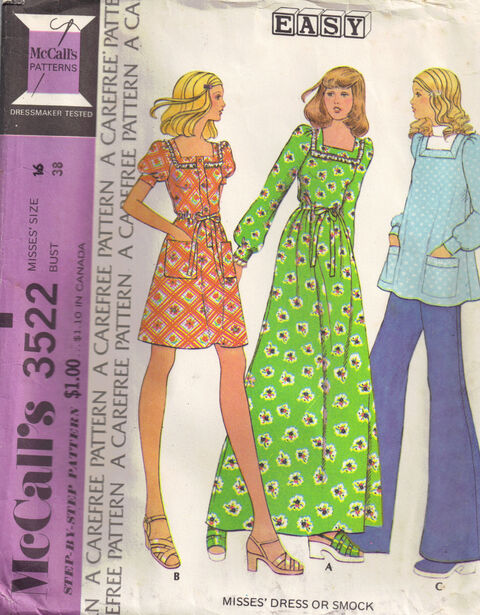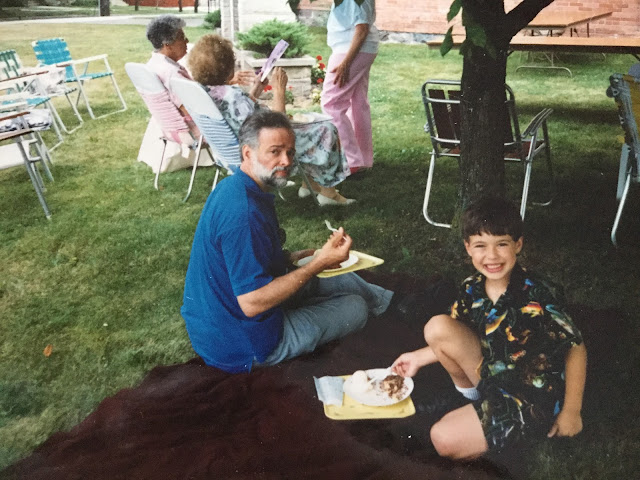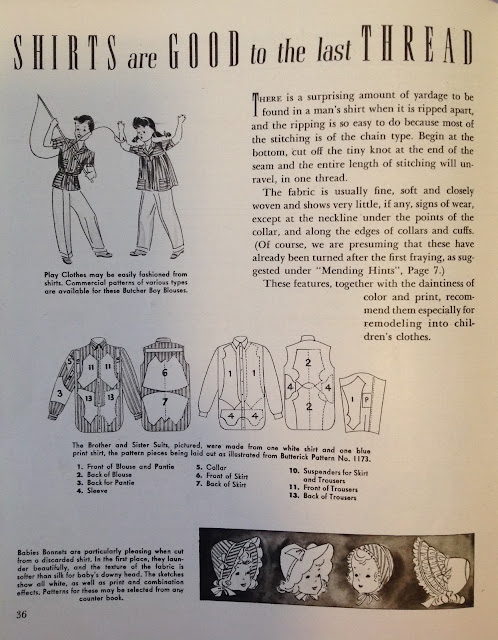In junior high, I had a required class in home sewing. We made an apron the Bishop Method and then an A-line skirt with darts and a back zipper. I chose to make a deep purple skirt. By the next year, I had outgrown it.
I really liked sewing and imagined making all my own clothing, just as I had dreamed of making Barbie doll clothes a few years before. Mom bought a used machine but she had trouble with it and nothing was made.
My mother-in-law was an addicted sewer. She was making all her own clothes, even pjamas and underwear! I taught myself to sew after my husband bought me a sewing machine for our first Christmas in 1972. While he studied in the evening, I kept busy with my Singer.
 |
| One of my early projects was a snap front robe made with prequilted material. Christmas 1973, me with our litter box trained pet rabbit. |
Before he graduated I was making dresses, t-shirts, blouses, jeans, and skirts. I made leisure-suit coats and even a cassock for Gary! I learned by doing. My first sewing class was a gift when I graduated from university in 1978; I received a Stretch-and-Sew class voucher. I made a swimsuit.
I recently found a great resource for vintage patterns. It was fun identifying patterns I remember making.
This jumper pattern was one of my earlest projects. I made the short version in a yellow and purple acrylic big plaid. I loved the big pockets. I'm shocked there are no photos of me wearing it. I wore it every week to work with a full sleeve white blouse with a deep pointed collar.
These were the days of the 'leisure suit' and I made some coats for Gary, as well as ties, a bathrobe, and a cassock.
This jumper pattern was one of my earlest projects. I made the short version in a yellow and purple acrylic big plaid. I loved the big pockets. I'm shocked there are no photos of me wearing it. I wore it every week to work with a full sleeve white blouse with a deep pointed collar.
 |
| McCall's 3522; ©1973; Misses Dress or Smock. Pullover dress or smock has puffed sleeves. Long sleeves gather into snapped cuffs. A, B, with drawstring in waistline casing has rick rack and eyelet or lace ruffling. B with Button trimmed front band or C with trimming has patch pockets. |
These were the days of the 'leisure suit' and I made some coats for Gary, as well as ties, a bathrobe, and a cassock.
 |
| My husband in a leisure suit coat I made. 1973. |
 |
In 1978 I made a jacket similar to the green one in the middle on the above pattern. I bought a black and white tweed fabric at a designer fabric warehouse in Northeast Philadelphia. Gary wore the jacket when we picked up a vacuum cleaner we won at a local appliance store. I am wearing a woven plaid jacket I made. It had a belt, but it looks unbelted in this photo.
I made this dress for my husband's graduation.
Not a good photo, but I made lots of T-shirts like I have on in the photo below, taken on a trip to the Finger Lakes.
This top could be worn over a turtleneck. Once again...big pockets! I don't recall if I made this pattern or not, but I know I owned it.
The top on the far right on the pattern below is like one I made and embellished with the built-in stitches on my Bernina 830. I often wore it with bell bottom jeams when I was first attending Temple University.
I made this jumper and blouse around 1979. The blouse had a short stand-up collar and narrow cuffs. The dress was a wrap-around with a front and back panel that tied at the waist.
I wore this dress to class during my last semester at university. It had narrow pleats in the yoke.
Around 1980 I got this awful perm, so that dates this dress that I made. The photos were taken at Longwood Gardens in Chester Co, PA.
It had a buttoned bodice. I needed a class in how to adjust patterns to fit better since I was no longer a straight size.
I adored the Folkwear patterns and collected a few but the only one I made was this prairie dress. I wore it for Thanksgiving dinner.
I made this prairie skirt in a small blue and white check.
I loved, loved, loved this coat! The hood and deep pockets were so useful. I made it a herringbone woven fabric in brown and burgundy.
When I found a patternless dress in a magazine I made it quite a few times. It made a good pregnancy dress. It used the width of the fabric for the skirt and top, cutting out a hole for the head.
 |
| 1987 at my baby shower |
I made this maternity dress with a large color and huge bow.
I wore this knit dress for our son's christening. It had dolman sleeves and a gathered waist.
Below, on the right, I am in a patternless outfit holding Chris in a shirt and overall I made that had bunnies on the bib. I enjoyed making lots of clothes for my baby and toddler.
I made this jacket for our son several times. It closed with velcro.
I made this paisley dress in the early 1990s, one of the last items I sewed for myself.
A short set I made our son. He would chose fabrics.








































